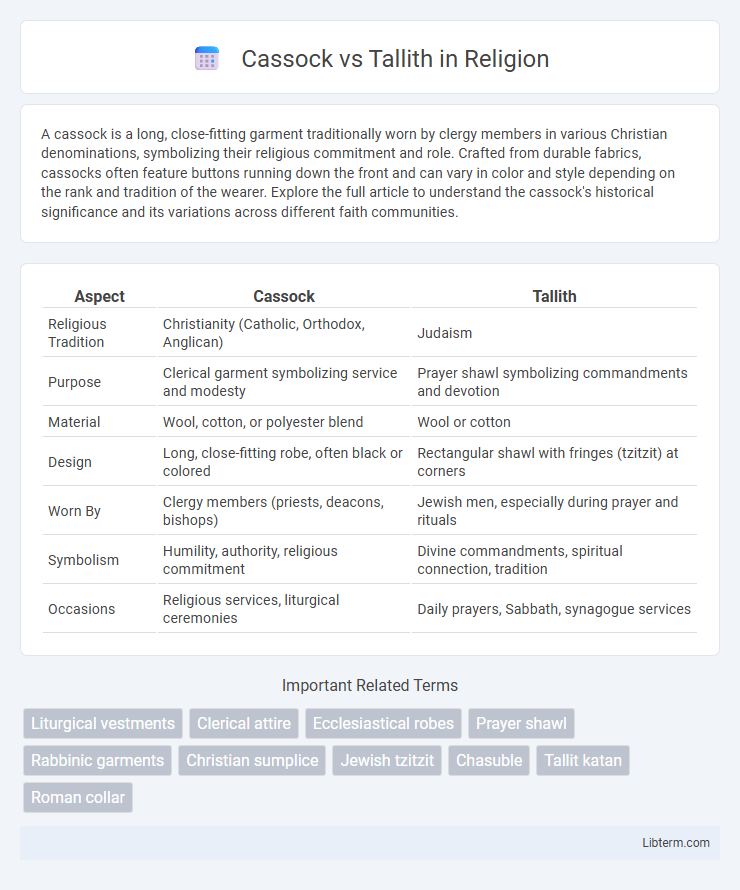A cassock is a long, close-fitting garment traditionally worn by clergy members in various Christian denominations, symbolizing their religious commitment and role. Crafted from durable fabrics, cassocks often feature buttons running down the front and can vary in color and style depending on the rank and tradition of the wearer. Explore the full article to understand the cassock's historical significance and its variations across different faith communities.
Table of Comparison
| Aspect | Cassock | Tallith |
|---|---|---|
| Religious Tradition | Christianity (Catholic, Orthodox, Anglican) | Judaism |
| Purpose | Clerical garment symbolizing service and modesty | Prayer shawl symbolizing commandments and devotion |
| Material | Wool, cotton, or polyester blend | Wool or cotton |
| Design | Long, close-fitting robe, often black or colored | Rectangular shawl with fringes (tzitzit) at corners |
| Worn By | Clergy members (priests, deacons, bishops) | Jewish men, especially during prayer and rituals |
| Symbolism | Humility, authority, religious commitment | Divine commandments, spiritual connection, tradition |
| Occasions | Religious services, liturgical ceremonies | Daily prayers, Sabbath, synagogue services |
Introduction to Cassock and Tallith
The cassock is a long, close-fitting garment traditionally worn by clergy in Christian denominations, symbolizing humility and devotion. The tallith, also spelled tallit, is a Jewish prayer shawl adorned with tzitzit (fringes) on its corners, representing the commandments in the Torah. Both items serve as significant religious attire, embodying deep spiritual meaning within their respective faiths.
Historical Origins of Cassock
The cassock originated in the early Christian church as a simple, ankle-length garment worn by clergy to symbolize modesty and uniformity, evolving from Roman tunics used during the Roman Empire. Its development throughout the Middle Ages cemented its role as a distinctive clerical attire, differentiating clergy from laypersons. In contrast, the tallith, a traditional Jewish prayer shawl, traces its origins to ancient Israelite commandments, serving a religious and ritual function rather than a clerical uniform.
Historical Roots of Tallith
The tallith, also spelled tallit, is a traditional Jewish prayer shawl with origins tracing back to biblical times, serving as a symbolic garment to fulfill the commandment of wearing fringes (tzitzit) on the corners of a four-cornered cloak. Unlike the cassock, a Christian clerical robe with roots in Roman tunics and developed during the Middle Ages for priestly functions, the tallith carries profound spiritual significance linked to Jewish law and identity. Its historical roots emphasize continuity in Jewish worship practices, reflecting a tangible connection to ancient covenantal commandments.
Religious Significance of Cassock
The cassock holds profound religious significance as a traditional Christian clerical garment symbolizing modesty, humility, and dedication to spiritual duties. Worn mainly by priests, deacons, and seminarians, its design and color often denote rank, order, and denomination within the church hierarchy. Unlike the tallith, which is a Jewish prayer shawl worn during worship to fulfill specific commandments, the cassock functions as everyday clerical attire representing the cleric's commitment and identity in the Christian faith.
Spiritual Meaning of Tallith
The tallith, or tallit, holds deep spiritual significance in Jewish tradition, symbolizing the commandments and divine presence through its fringes known as tzitzit, which serve as constant reminders of faith and moral obligations. Unlike the cassock, a clerical garment primarily associated with Christian clergy and representing ecclesiastical authority and service, the tallith functions as a sacred prayer shawl embodying spiritual devotion, humility, and connection to God during worship. Its use during prayer rituals fosters mindfulness and reverence, reinforcing identity and commitment within the Jewish spiritual practice.
Cassock in Christian Traditions
The cassock is a long, close-fitting garment traditionally worn by clergy in many Christian denominations, symbolizing modesty and clerical authority. It differs significantly from the tallith, a Jewish prayer shawl used primarily during worship and religious ceremonies. In Christian traditions, the cassock often serves as the foundational clerical attire, varying in color and style to denote rank or liturgical season.
Tallith in Jewish Worship
A tallith, also spelled tallit, is a traditional Jewish prayer shawl worn during worship, symbolizing the commandments and spirituality, distinguished by its fringes called tzitzit on the four corners. Unlike a cassock, which is a Christian clerical garment, the tallith holds deep religious significance in Jewish rituals such as morning prayers, Sabbath, and festivals. The tallith serves as a physical reminder of faith and adherence to God's laws, central to Jewish identity and communal worship.
Key Differences: Material, Design, and Usage
The cassock is traditionally made from heavy wool or polyester blends, featuring a long, ankle-length design with buttons down the front, primarily worn by clergy in Christian liturgical settings. In contrast, the tallith (or tallit) is a lightweight rectangular Jewish prayer shawl made from wool or silk, characterized by fringes called tzitzit at its corners, and is draped over the shoulders during prayer services. Usage differs significantly as the cassock serves as clerical attire symbolizing religious office, while the tallith functions as a ritual garment for spiritual focus and commandments observance in Judaism.
Symbolism and Rituals Associated
The cassock symbolizes clerical authority and devotion, often worn by clergy during liturgical services to denote their religious office and humility. The tallith, a Jewish prayer shawl, holds deep spiritual significance as a reminder of the commandments, traditionally worn during morning prayers and important religious ceremonies. Both garments serve as powerful symbols within their respective rituals, embodying faith, tradition, and identity.
Modern Perspectives on Cassock and Tallith
The modern cassock remains a symbol of clerical identity, often adapted with simplified designs and versatile fabrics to suit contemporary liturgical settings and daily clergy wear. The tallith continues to hold profound spiritual significance in Jewish worship, with innovations such as varying thread counts and personalized embroidery reflecting individual and communal identity. Both garments exemplify evolving religious traditions that balance historical reverence with modern cultural expressions.
Cassock Infographic

 libterm.com
libterm.com